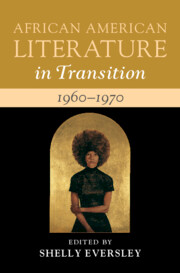Book contents
- African American Literature in Transition, 1960–1970
- African American Literature In Transition
- African American Literature in Transition, 1960–1970
- Copyright page
- Contents
- Contributors
- Preface
- Acknowledgments
- Chronology
- Introduction
- I Poetry and Music
- II Culture and Politics
- III Beyond the Canon
- Chapter 9 Meanwhile, Back on the Home Front
- Chapter 10 Radio Free Dixie, Black Arts Radio, and African American Women’s Activism
- Index
- References
Chapter 9 - Meanwhile, Back on the Home Front
from III - Beyond the Canon
Published online by Cambridge University Press: 10 November 2022
- African American Literature in Transition, 1960–1970
- African American Literature In Transition
- African American Literature in Transition, 1960–1970
- Copyright page
- Contents
- Contributors
- Preface
- Acknowledgments
- Chronology
- Introduction
- I Poetry and Music
- II Culture and Politics
- III Beyond the Canon
- Chapter 9 Meanwhile, Back on the Home Front
- Chapter 10 Radio Free Dixie, Black Arts Radio, and African American Women’s Activism
- Index
- References
Summary
This chapter argues that Black community obtained as much in the 1960s as it did during the 1930s, and as Vincent O. Carter’s overlooked stream-of-consciousness novel, Such Sweet Thunder itself implies is inevitably the case, it was forged as much in the context of what we might call collective domesticity as in the properly political public sphere. Indeed, Carter’s novel offers up three primary mechanisms for the establishment and maintenance of African American community that, precisely because they are by no means unfamiliar, certainly have to have been deployed throughout the entire period during which Carter was seeking a publisher: social dance and musical enjoyment; communal food preparation and consumption; and storytelling. If we trace some of the ways these mechanisms were implemented in that 1960s historical context, as this chapter explains, we can arrive at a fuller understanding of what constituted African American life during the period than if we focus on political activity alone, with the likely result that we will also arrive at an expanded conception of African American literary culture during this pivotal decade.
- Type
- Chapter
- Information
- African American Literature in Transition, 1960–1970Black Art, Politics, and Aesthetics, pp. 229 - 252Publisher: Cambridge University PressPrint publication year: 2022



